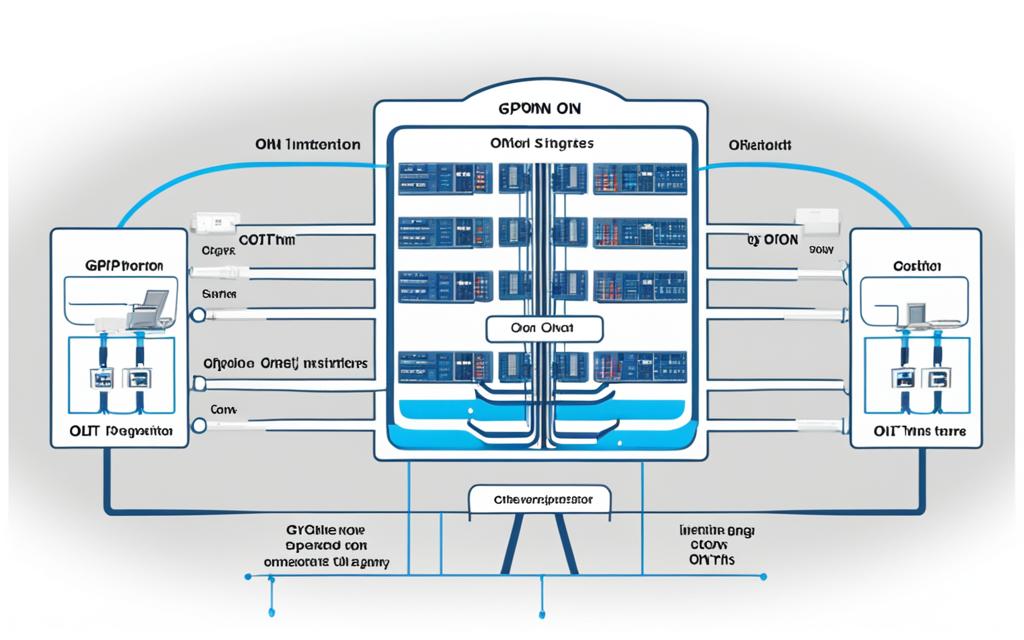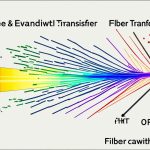In today’s digital age, high-speed internet has become an essential part of our lives. Whether it’s for streaming videos, conducting business, or staying connected with loved ones, a reliable and fast internet connection is crucial. This is where Gigabit Passive Optical Networks (GPON) come into play.
GPON is an advanced telecommunications technology that utilizes optical fibers and passive components like optical splitters to deliver high-speed internet and other services to homes and businesses. It is a shared infrastructure, meaning multiple users or customers share the same optical fiber, making it a cost-effective and efficient solution.
The core components of a GPON network include the Optical Line Terminal (OLT) at the central office, optical fibers for data transmission, optical splitters for signal distribution, and Optical Network Units (ONUs) installed at customer premises. The OLT sends optical signals through the optical fibers, and the ONUs convert them into electrical signals for distribution to customer devices.
GPON networks offer numerous advantages, including high-speed internet access, cost-efficiency for service providers, scalability, reliability, security, and privacy. However, there are also limitations such as shared bandwidth and limited upstream bandwidth during peak usage times.
Despite these limitations, GPON technology plays a significant role in bridging the digital divide, enabling smart cities and IoT, and driving innovations in telecommunications. It brings connectivity to remote and underserved areas, enhances public services, and contributes to economic growth and technological progress.
In the following sections, we will delve deeper into understanding GPON technology, how it works, the pros and cons, and the overall significance of GPON in today’s world of high-speed internet.
Understanding GPON Technology
GPON technology is a telecommunications solution that utilizes optical fibers and passive components to deliver high-speed internet, television, and other services. The key feature of GPON is its efficient use of optical splitters to distribute the optical signal from the central office to multiple Optical Network Units (ONUs) installed at customer premises. The GPON network is governed by the Optical Line Terminal (OLT), which acts as the brain of the system, managing data distribution and communication with the ONUs.
Optical fibers serve as the data highway in GPON networks, transmitting data signals in the form of light between the OLT and ONUs. This optical transmission ensures fast and reliable data transfer, enabling users to access high-speed internet and enjoy seamless connectivity.
When the optical signal reaches the ONUs, they convert it into electrical signals that can be used by customer devices, such as computers, phones, or TVs. This conversion process allows for the utilization of the transmitted data and ensures compatibility with a wide range of customer devices.
Key Components of GPON Technology
GPON technology encompasses several key components that work together to provide high-speed telecommunications services:
- Optical Line Terminal (OLT): The OLT acts as the main hub of the GPON network, managing data transmission and communication with the ONUs. It controls the flow of traffic, allocates bandwidth, and ensures efficient utilization of the network resources.
- Optical Fibers: Optical fibers are the backbone of a GPON network, serving as the medium for data transmission. They enable the transfer of optical signals from the OLT to the ONUs over long distances with minimal signal loss.
- Optical Splitters: Optical splitters play a crucial role in a GPON network by efficiently distributing the optical signal from the OLT to multiple ONUs. They divide the incoming signal into multiple paths, enabling simultaneous data transmission to various customer premises.
- Optical Network Units (ONUs): ONUs are devices installed at customer premises that receive the optical signal from the OLT and convert it into electrical signals. These signals are then used to provide high-speed internet, television, and other services to customer devices.
By leveraging GPON technology, telecommunications providers can deliver high-speed internet and advanced services to a large number of users, ensuring reliable connectivity and meeting the growing demands of today’s digital world.
| Benefits of GPON Technology | Limitations of GPON Technology |
|---|---|
| – High-speed internet access | – Shared bandwidth during peak usage times |
| – Cost-efficiency for service providers | – Limited upstream bandwidth |
| – Scalability for future growth | – High deployment costs |
| – Reliability and network redundancy | – Time-consuming installation challenges |
| – Enhanced security and privacy |
As GPON technology continues to evolve, advancements in optical fiber technology, increased bandwidth capacities, and improved network management systems promise to further enhance the performance and capabilities of GPON networks.
How Does GPON Work?
GPON networks operate through an interplay of optical fibers, optical splitters, and equipment such as the OLT and ONUs.
Data transmission in GPON occurs when a customer requests data, and the OLT sends the requested data as optical signals down the optical fibers to the ONUs.
Optical splitters divide the incoming optical signal from the OLT into multiple paths, leading to individual ONUs.
ONUs receive and convert the optical signals into electrical signals for distribution to customer devices.
GPON networks incorporate security measures to protect data during transmission and quality of service mechanisms to prioritize certain types of data traffic.
GPON networks are shared infrastructures, with the OLT efficiently managing the allocation of available bandwidth among users.
GPON Network Structure
| Component | Description |
|---|---|
| Optical Line Terminal (OLT) | The central office equipment that communicates with ONUs and manages data distribution. |
| Optical Fibers | Serve as the data highway, transmitting data signals in the form of light between the OLT and ONUs. |
| Optical Splitters | Divide the incoming optical signal from the OLT into multiple paths, leading to individual ONUs. |
| Optical Network Units (ONUs) | Installed at customer premises, receive and convert optical signals into electrical signals for distribution to customer devices. |

Pros and Cons of GPON Technology
GPON technology offers several advantages that make it an attractive option for high-speed internet access. Some of the key advantages include:
- High-speed internet access: GPON provides gigabit-level broadband speeds, ensuring fast and reliable internet connectivity for users.
- Cost-efficiency: GPON allows service providers to reduce costs per subscriber by utilizing shared infrastructure and efficient bandwidth allocation.
- Scalability: GPON networks can easily accommodate a growing number of subscribers without significant infrastructure upgrades, making scalability a breeze.
- Reliability: With its use of optical fibers and passive components, GPON networks offer robust reliability, minimizing downtime and ensuring consistent service.
- Security and Privacy: GPON technology provides secure and private data transmission, protecting sensitive information from unauthorized access.
However, GPON technology also has its limitations that need to be considered:
- Shared bandwidth: During peak usage times, the available bandwidth in GPON networks may be shared among users, leading to potential slowdowns.
- Limited upstream bandwidth: GPON networks typically have a higher downstream bandwidth than upstream, which can impact activities that require significant upload speeds.
- Deployment costs: Setting up a GPON network requires initial investment in fiber optic infrastructure and equipment, which can be expensive.
- Installation challenges: Installing GPON networks may involve complex processes, requiring expertise in fiber optics and network configuration.
Cost-Efficiency Comparison
Let’s compare the cost-efficiency aspects of GPON technology with traditional copper-based internet connections:
| Cost Factors | GPON Technology | Traditional Copper-Based Connection |
|---|---|---|
| Deployment Costs | Requires initial investment in fiber optic infrastructure and equipment | Requires deployment of copper cables and related equipment |
| Operational Costs | Lower maintenance and operational costs due to shared infrastructure | Higher maintenance and operational costs for individual copper connections |
| Scalability | Easy scalability without significant infrastructure upgrades | Requires additional infrastructure upgrades for scalability |
As the table above illustrates, GPON technology offers superior cost-efficiency compared to traditional copper-based connections. The initial investment in fiber optic infrastructure is offset by lower operational costs and the ability to scale the network without extensive upgrades.
Despite the limitations, GPON technology remains a popular choice for high-speed internet access due to its numerous advantages and the increasing demand for reliable and efficient connectivity.

Conclusion
GPON networks are a crucial component of the modern digital landscape, providing high-speed internet access and digital connectivity to homes and businesses. Through the use of optical fibers and passive components, GPON technology has revolutionized the way we connect to the digital world, making it faster, more reliable, and accessible to a wider range of users.
While GPON networks offer numerous advantages, it is important to consider their limitations and evaluate them against your specific connectivity needs. One of the significant advantages of GPON is its role in bridging the digital divide, bringing high-speed internet access to remote and underserved areas. Additionally, GPON technology enables the development of smart cities and the Internet of Things (IoT), driving innovation and progress in the telecommunications industry.
As our reliance on the internet continues to grow, GPON networks will likely remain a cornerstone of modern telecommunications. They provide seamless connectivity to the vast online universe, enhancing both personal and professional digital experiences. As you consider your internet options, the significance of GPON for high-speed internet access and digital connectivity cannot be overstated.
FAQ
What is GPON technology?
GPON, which stands for Gigabit Passive Optical Networks, is a telecommunications technology that utilizes optical fibers and passive components like optical splitters to deliver high-speed internet, television, and other services to homes and businesses.
What are the core components of a GPON network?
The core components of a GPON network include the Optical Line Terminal (OLT) at the central office, optical fibers for data transmission, optical splitters for efficient signal distribution, and Optical Network Units (ONUs) installed at customer premises.
How does data transmission work in a GPON network?
Data transmission in a GPON network involves the OLT sending optical signals through the optical fibers to the ONUs, which convert the signals into electrical signals for distribution to customer devices.
What does it mean for GPON networks to be shared infrastructures?
GPON networks are shared infrastructures, meaning multiple users or customers share the same optical fiber. Bandwidth allocation is managed by the OLT to ensure fair sharing and network efficiency.
What are the advantages of GPON technology?
The advantages of GPON technology include high-speed internet access, cost-efficiency for service providers, scalability, reliability, security, and privacy.
Are there any limitations to GPON technology?
Yes, there are limitations to GPON technology, such as shared bandwidth during peak usage times, limited upstream bandwidth, high deployment costs, and time-consuming installation challenges.
How does GPON technology contribute to bridging the digital divide?
GPON technology plays a significant role in bridging the digital divide by bringing connectivity to remote and underserved areas, enhancing public services, and contributing to economic growth and technological progress.




















Адвокат Запорожье — юрист Запорожье. Военный адвокат Запорожье. Помощь опытных адвокатов в Запорожье и Запорожской области. Любые виды юридических услуг и консультаций адвокатов
[url=https://advokaty.zp.ua/]Адвокат Дніпро[/url]
Профессиональная круглосуточная поддержка адвоката позволяет держать в курсе дела и во время принимать необходимые меры. Вся информация о нас находится в реестре Адвокатов Украины, документы, подтверждающие наши полномочия, будут представлены при личной встрече.
Адвокат Запорожье. Военный адвокат Запорожье. Мы — команда адвокатов по международному, национальному и военному праву, с многолетним опытом практической работы. Наши сотрудники — члены Национальной ассоциации Адвокатов Украины, а некоторые и члены Международных обществ и организаций.
У нас нет молодых специалистов, которые на делах клиентов набираются опыта. Наша работа – это наше хобби, поэтому к каждому делу мы относимся ответственно, подбирая индивидуальный подход. Мы знаем, что нужно делать, чтобы выиграть Ваше дело.